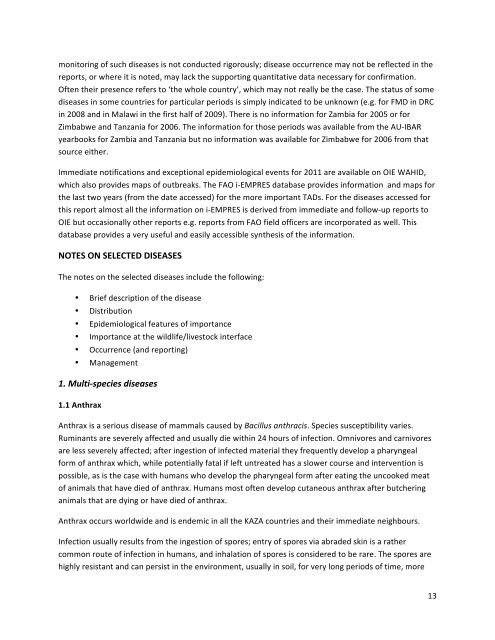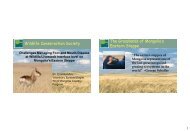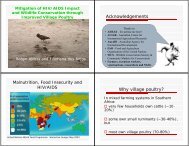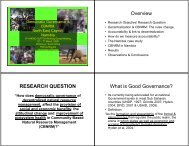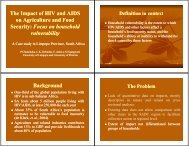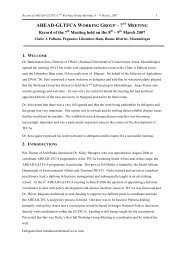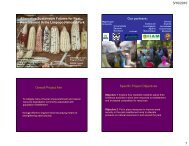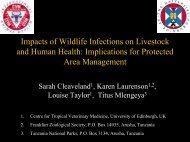Download - Animal & Human Health for the Environment and ...
Download - Animal & Human Health for the Environment and ...
Download - Animal & Human Health for the Environment and ...
Create successful ePaper yourself
Turn your PDF publications into a flip-book with our unique Google optimized e-Paper software.
monitoring of such diseases is not conducted rigorously; disease occurrence may not be reflected in <strong>the</strong> reports, or where it is noted, may lack <strong>the</strong> supporting quantitative data necessary <strong>for</strong> confirmation. Often <strong>the</strong>ir presence refers to ‘<strong>the</strong> whole country’, which may not really be <strong>the</strong> case. The status of some diseases in some countries <strong>for</strong> particular periods is simply indicated to be unknown (e.g. <strong>for</strong> FMD in DRC in 2008 <strong>and</strong> in Malawi in <strong>the</strong> first half of 2009). There is no in<strong>for</strong>mation <strong>for</strong> Zambia <strong>for</strong> 2005 or <strong>for</strong> Zimbabwe <strong>and</strong> Tanzania <strong>for</strong> 2006. The in<strong>for</strong>mation <strong>for</strong> those periods was available from <strong>the</strong> AU-‐IBAR yearbooks <strong>for</strong> Zambia <strong>and</strong> Tanzania but no in<strong>for</strong>mation was available <strong>for</strong> Zimbabwe <strong>for</strong> 2006 from that source ei<strong>the</strong>r. Immediate notifications <strong>and</strong> exceptional epidemiological events <strong>for</strong> 2011 are available on OIE WAHID, which also provides maps of outbreaks. The FAO i-‐EMPRES database provides in<strong>for</strong>mation <strong>and</strong> maps <strong>for</strong> <strong>the</strong> last two years (from <strong>the</strong> date accessed) <strong>for</strong> <strong>the</strong> more important TADs. For <strong>the</strong> diseases accessed <strong>for</strong> this report almost all <strong>the</strong> in<strong>for</strong>mation on i-‐EMPRES is derived from immediate <strong>and</strong> follow-‐up reports to OIE but occasionally o<strong>the</strong>r reports e.g. reports from FAO field officers are incorporated as well. This database provides a very useful <strong>and</strong> easily accessible syn<strong>the</strong>sis of <strong>the</strong> in<strong>for</strong>mation. NOTES ON SELECTED DISEASES The notes on <strong>the</strong> selected diseases include <strong>the</strong> following: • Brief description of <strong>the</strong> disease • Distribution • Epidemiological features of importance • Importance at <strong>the</strong> wildlife/livestock interface • Occurrence (<strong>and</strong> reporting) • Management 1. Multi-‐species diseases 1.1 Anthrax Anthrax is a serious disease of mammals caused by Bacillus anthracis. Species susceptibility varies. Ruminants are severely affected <strong>and</strong> usually die within 24 hours of infection. Omnivores <strong>and</strong> carnivores are less severely affected; after ingestion of infected material <strong>the</strong>y frequently develop a pharyngeal <strong>for</strong>m of anthrax which, while potentially fatal if left untreated has a slower course <strong>and</strong> intervention is possible, as is <strong>the</strong> case with humans who develop <strong>the</strong> pharyngeal <strong>for</strong>m after eating <strong>the</strong> uncooked meat of animals that have died of anthrax. <strong>Human</strong>s most often develop cutaneous anthrax after butchering animals that are dying or have died of anthrax. Anthrax occurs worldwide <strong>and</strong> is endemic in all <strong>the</strong> KAZA countries <strong>and</strong> <strong>the</strong>ir immediate neighbours. Infection usually results from <strong>the</strong> ingestion of spores; entry of spores via abraded skin is a ra<strong>the</strong>r common route of infection in humans, <strong>and</strong> inhalation of spores is considered to be rare. The spores are highly resistant <strong>and</strong> can persist in <strong>the</strong> environment, usually in soil, <strong>for</strong> very long periods of time, more 13


